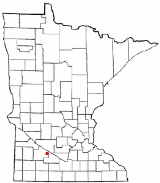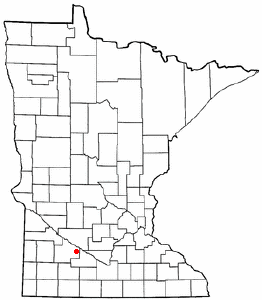
Morgan, Minnesota
Encyclopedia
Morgan is a city in Redwood County
, Minnesota
, United States
. The population was 896 at the 2010 census.
 According to the United States Census Bureau
According to the United States Census Bureau
, the city has a total area of 0.6 square miles (1.6 km²), all of it land.
Morgan is located at the intersection of Minnesota Highway 67
and Minnesota Highway 68
.
of 2000, there were 903 people, 377 households, and 243 families residing in the city. The population density
was 1,644.3 people per square mile (633.9/km²). There were 423 housing units at an average density of 770.3 per square mile (296.9/km²). The racial makeup of the city was 97.34% White, 0.33% Native American, 0.11% Asian, 0.55% from other races
, and 1.66% from two or more races. Hispanic or Latino of any race were 1.88% of the population.
There were 377 households out of which 27.3% had children under the age of 18 living with them, 56.2% were married couples
living together, 6.9% had a female householder with no husband present, and 35.3% were non-families. 32.4% of all households were made up of individuals and 20.2% had someone living alone who was 65 years of age or older. The average household size was 2.29 and the average family size was 2.90.
In the city the population was spread out with 24.4% under the age of 18, 6.3% from 18 to 24, 21.3% from 25 to 44, 17.9% from 45 to 64, and 30.1% who were 65 years of age or older. The median age was 43 years. For every 100 females there were 83.9 males. For every 100 females age 18 and over, there were 81.2 males.
The median income for a household in the city was $30,673, and the median income for a family was $40,096. Males had a median income of $27,031 versus $21,250 for females. The per capita income
for the city was $16,454. About 4.2% of families and 5.8% of the population were below the poverty line, including 5.9% of those under age 18 and 8.0% of those age 65 or over.
Redwood County, Minnesota
As of the census of 2000, there were 16,815 people, 6,674 households, and 4,524 families residing in the county. The population density was 19 people per square mile . There were 7,230 housing units at an average density of 8 per square mile...
, Minnesota
Minnesota
Minnesota is a U.S. state located in the Midwestern United States. The twelfth largest state of the U.S., it is the twenty-first most populous, with 5.3 million residents. Minnesota was carved out of the eastern half of the Minnesota Territory and admitted to the Union as the thirty-second state...
, United States
United States
The United States of America is a federal constitutional republic comprising fifty states and a federal district...
. The population was 896 at the 2010 census.
Geography

United States Census Bureau
The United States Census Bureau is the government agency that is responsible for the United States Census. It also gathers other national demographic and economic data...
, the city has a total area of 0.6 square miles (1.6 km²), all of it land.
Morgan is located at the intersection of Minnesota Highway 67
Minnesota State Highway 67
Minnesota State Highway 67 is a highway in southwest Minnesota, which runs from its intersection with U.S. Highway 75 in Oshkosh Township near Canby and continues east and southeast to its eastern terminus at its intersection with State Highway 68 in Morgan....
and Minnesota Highway 68
Minnesota State Highway 68
Minnesota State Highway 68 is a highway in southwest and south-central Minnesota, which runs from South Dakota Highway 22 at the South Dakota state line near Canby, and continues east to its eastern terminus at its intersection with U.S...
.
Demographics
As of the censusCensus
A census is the procedure of systematically acquiring and recording information about the members of a given population. It is a regularly occurring and official count of a particular population. The term is used mostly in connection with national population and housing censuses; other common...
of 2000, there were 903 people, 377 households, and 243 families residing in the city. The population density
Population density
Population density is a measurement of population per unit area or unit volume. It is frequently applied to living organisms, and particularly to humans...
was 1,644.3 people per square mile (633.9/km²). There were 423 housing units at an average density of 770.3 per square mile (296.9/km²). The racial makeup of the city was 97.34% White, 0.33% Native American, 0.11% Asian, 0.55% from other races
Race (United States Census)
Race and ethnicity in the United States Census, as defined by the Federal Office of Management and Budget and the United States Census Bureau, are self-identification data items in which residents choose the race or races with which they most closely identify, and indicate whether or not they are...
, and 1.66% from two or more races. Hispanic or Latino of any race were 1.88% of the population.
There were 377 households out of which 27.3% had children under the age of 18 living with them, 56.2% were married couples
Marriage
Marriage is a social union or legal contract between people that creates kinship. It is an institution in which interpersonal relationships, usually intimate and sexual, are acknowledged in a variety of ways, depending on the culture or subculture in which it is found...
living together, 6.9% had a female householder with no husband present, and 35.3% were non-families. 32.4% of all households were made up of individuals and 20.2% had someone living alone who was 65 years of age or older. The average household size was 2.29 and the average family size was 2.90.
In the city the population was spread out with 24.4% under the age of 18, 6.3% from 18 to 24, 21.3% from 25 to 44, 17.9% from 45 to 64, and 30.1% who were 65 years of age or older. The median age was 43 years. For every 100 females there were 83.9 males. For every 100 females age 18 and over, there were 81.2 males.
The median income for a household in the city was $30,673, and the median income for a family was $40,096. Males had a median income of $27,031 versus $21,250 for females. The per capita income
Per capita income
Per capita income or income per person is a measure of mean income within an economic aggregate, such as a country or city. It is calculated by taking a measure of all sources of income in the aggregate and dividing it by the total population...
for the city was $16,454. About 4.2% of families and 5.8% of the population were below the poverty line, including 5.9% of those under age 18 and 8.0% of those age 65 or over.

